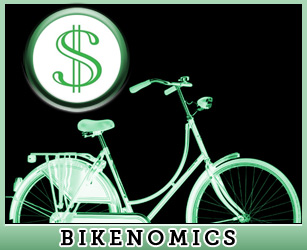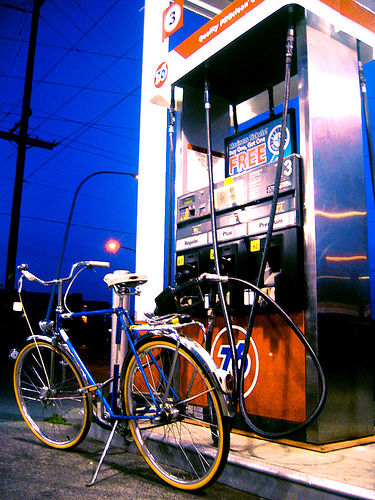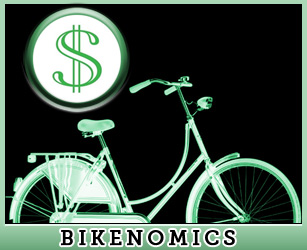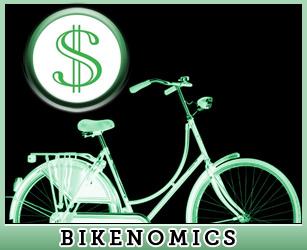 This is the seventh column in a series focusing on the economics of bicycling.
This is the seventh column in a series focusing on the economics of bicycling.
More and more of us have less and less money these days.
Fortunately, there are a lot of things you don’t need money to do, and bicycling is one of them.
When you’re broke, a bicycle can help a lot. Financially, for starters. Cars are expensive beasts. If you make less than $70,000 a year, you probably spend almost 20 percent of your household income on transportation. That’s more than you spend on food.
But bicycling also has lots of other benefits — the kind that shouldn’t have anything to do with money, but that are all too elusive when you have none. Health. Lack of stress. Community. Fun. Joy. Civic participation. Bicycling makes you feel free, and when you feel that way you believe that more is possible.
So here’s a short guide to bicycling through the new, not-so-great Depression.
In true Depression style, your first step is to not buy anything.
There’s a good chance you already have a bike in your household — most people do. Grab it! If you don’t have a bike in your house, borrow one from a family member or neighbor, preferably someone who’s about your height.
Borrowing will save you from buying a bike you hate, one that will fill you with guilt whenever you walk past it to the car or the bus stop. It will teach you what you do and do not want out of a bike. It will remind you that you have generous friends.
 Here’s one thing you won’t be spending money on if you get out there and ride.Photo: Josh ParrishOnce you have that bike, ride it! Ride it wherever you like. If this means down the corner to get milk from the store, don’t forget to bring your backpack. If this means 5 or 10 miles to work, spend some time with a map first to find routes that don’t suck. Some places, including New York and Chicago, are covered by an app called Ride the City that can tell you the safest and/or fastest routes around town, and Google Maps has also started offering biking directions.
Here’s one thing you won’t be spending money on if you get out there and ride.Photo: Josh ParrishOnce you have that bike, ride it! Ride it wherever you like. If this means down the corner to get milk from the store, don’t forget to bring your backpack. If this means 5 or 10 miles to work, spend some time with a map first to find routes that don’t suck. Some places, including New York and Chicago, are covered by an app called Ride the City that can tell you the safest and/or fastest routes around town, and Google Maps has also started offering biking directions.
If you can find someone to ride with, even better. Put some air in the tires — if you don’t have a pump, your nearest bike shop will gladly let you use theirs. Take a minute to familiarize yourself with some safe riding basics, and give the bike a basic checkup. And go!
There is one expense you cannot escape: Fuel. You may not be guzzling gas, but you’ll be inhaling burritos. You’ll eat more, and you’ll find that the very cheapest food on the market, the fried and processed bready stuff, just doesn’t get you up those hills. This all costs something, but it’s nothing next to the price of inactivity.
Other things that tend to cost money are the key basic accessories: A $40 U-lock, a bell, a white front light and a red rear light — the $7 ones are fine. Also consider a helmet and a front basket or rear rack. You may be able to borrow these things or find them at yard sales. If you can’t, they’re worth the investment. Everything else, you can find or cobble together. Garbage bags make fine rain capes in a pinch; milk crates will carry everything you need.
At some point, if you don’t like your neighbor’s bike or if they aren’t interested in trading it for your old push mower, you’ll need to do some shopping. Figure out your budget and what you absolutely need from a bike: Speed? Cargo capacity? To sit upright? Start shopping around. Try local thrift stores, rummage sales, and the internet. See if you have a local bike shop that sells used bikes. See if someone else you know wants to sell or trade you theirs.
You should also know that there is a huge worldwide network of places where you can fix your bike, get parts and gear, and even get a new bike, for free.
They’re called bike co-ops or community bike projects. They host regular classes and also drop-in hours where patient volunteers will walk you through every step of fixing a flat or changing your brake pads. Everything is donated and then given away, though some places charge a small amount for time and parts. Many have programs where you can build up an entire bicycle for yourself, also for free, earning it through the hours you spend learning and doing.
There’s probably a bike co-op near you. If there isn’t, maybe you should start one.
When you’re broke — or even when you aren’t — the bicycle economy can be a revelation.
The bicycle economy is one that you create. A bike can be key to running a business, large or small. You can access jobs that you can’t get to by transit. You are free to go where you want, when you want.
Back to that bike you’re going to borrow. Having a community to help you out takes some of the loneliness out of being broke. One of the best things you can do for yourself when you’re broke is make connections with others, despite the barriers.
This is what the bicycle economy is all about. It’s an economy in which we are empowered, in which we are free and confident rather than stuck in debt and traffic, in which we don’t need as much of the scarce stuff because we have each other.
This doesn’t mean we don’t have constraints. There are a lot of places where bicycling is an uphill battle. The roads aren’t designed to accommodate bikes. The intersections are terrifying. The driving culture is aggressive. And frustratingly, the more broke you are the more likely you are to live somewhere that makes it difficult for you to get around without a car.
This hurts. When you live on a busy street, you have fewer friends and feel less connected to your community. There’s new research showing that when you live in less than “livable” neighborhood, particularly in a low-income area, it can literally take 20 years off your life.
That’s why, if you have an inkling that you might be able to bike sometimes, if for every busy road near you there is a quieter parallel route, or if you’re just tired of waiting for a government that may or may not get its act together, maybe it’s time to grab the bike by the handlebars and get out there and ride anyway.
Once we start, we may find these places becoming safer, our governments taking notice, our neighborhoods becoming more friendly. We may find we never want to stop.



